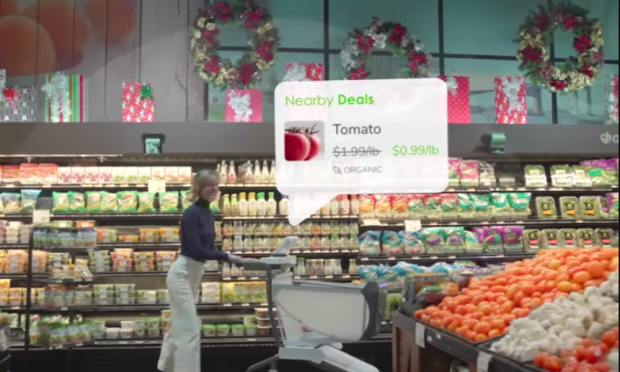Can Smart Carts Make Grocery Stores Smarter?

The shopping cart has been a part of the grocery store checkout experience for nearly 152 years. It’s first use is attributed to a Midwest grocer, Humpty Dumpty. Its owner wanted a solution that allowed shoppers to move more groceries around the store easily, so he invented it. Mass production and design tweaks followed. Today, shopping carts are as much a fixture in grocery stores as the frozen food aisle.
Shopping carts were invented to make the store experience more efficient, and increase the odds that shoppers would fill their baskets and drive more sales to the store. That’s also what motivated Caper CEO and Co-founder Lindon Gao to give it a makeover at the ripe old age of 152 — a makeover that would turn the cart into a smart checkout experience.
“I realized if there were a way to improve grocery shopping, you could bring people back into stores who liked physical shopping, but hated things like standing in line or having to search the shelves for items,” Gao told Karen Webster.
In his previous job as an investment banker covering retail for Goldman Sachs and JPMorgan, Gao had a front row seat into how to make grocery shopping more efficient. While there, he observed quite a few retail innovations that inspired what is now Caper. Gao recognized that eCommerce offered an incredibly compelling shopping proposition — no lines, no waiting, no schlepping bulky items around a store and to the car. Putting items into an online shopping cart acted as both the repository for those items as well as how checkout was done.
He also observed that, for as much as retail is changing, there are still contexts in which consumers might prefer the physical shopping experience, and grocery was one of those segments. People like to look at the food they are going to eat before they buy it. So, why not make a shopping cart that holds the items a shopper wants to purchase, but also eliminates the need to stand in line to buy those items?
How It Works
The Caper cart functions like a regular shopping cart, with a few notable exceptions. For one, they are more durable.
“We build these things to be tanks. You can kick them, crash them, abuse them and never make a dent,” Gao said.
For another matter, the carts also automatically check out the items that shoppers place inside them. The “tank-like” construction is essential, he noted, because the cart comes built with three cameras that take scores of photos of every item that goes into the cart, as well as weight sensors, a barcode scanner and a small screen.
Though the vision for Caper is to have a scanless shopping and checkout experience, scanning barcodes is essential in the pilot to build a database of item images mapped to stock-keeping units (SKUs) that are placed in those smart carts.
“Those images are part of the deep-learning training for our computer-visioning algorithm,” Gao explained to Webster. “Our approach is to eventually go totally scanless, and we are early on in enabling scanless in certain sectors.”
Taking items out of the cart — say, to substitute for other items — is scanless already, he noted, because the cart can scan weight and it knows when an object has been removed.
Another feature of the cart is that it does its own bagging. Well, sort of. Caper carts come equipped with their own bagging racks so that customers can bag their items as they go to add efficiency.
In addition, there is a small stop at the front of the store where customers can make card payments. That, Gao noted, is likely a temporary feature, though. Caper is working with its retail partners to connect the smart carts themselves to the store’s app so that customers can automatically check out with their saved credentials.
In a perfect world, he said, Caper technology will become so common that consumers forget it is there at all — so integrated into the journey that it becomes regular instead of something special.
Easing Into A More Digital Future
Gao said he and his team built smart carts for smaller regional stores that want to use technology to give their shoppers a better experience, but can’t afford to spend hundreds of thousands of dollars on redesigning their shelving or adding cameras to their stores.
The average grocery shop Caper works with today, Gao noted, is a small chain with fewer than 15 locations, working with stores of around 50,000 square feet. Tying the scanning to the cart is simpler from an infrastructure point of view, as the only integration that needs to be done is with the stores’ point-of-sale (POS) systems, which are not all that complex.
“When we tell grocery store operators that they can have all that function without an overhaul or a change in operations, other than adding these carts, [and that] the store can run as usual,” he said, they are more than intrigued. The cost, he added, for a full complement of these carts — enough for the average store — is roughly the same as two self-checkout machines.
Making Grocery Shopping Smarter
Gao said Caper’s pilots have made the company a lot smarter about what consumers value in a grocery store shopping experience.
For example, Gao told Webster, having a screen interface in the cart matters to consumers — even when it is used for something as simple as pointing them to the products advertised in the store’s weekly circular. Just showing the customer that, and where in the store to get the item, can increase basket size by as much as 18 percent.
Even though Caper doesn’t have specific data on the relationship between Caper carts and store loyalty, Gao said that the company sees a lot of repeat users on the carts, particularly moms with kids.
“Our goal is that this is going to be the preferred way, if not the only way, for customers to grocery shop,” he said.
